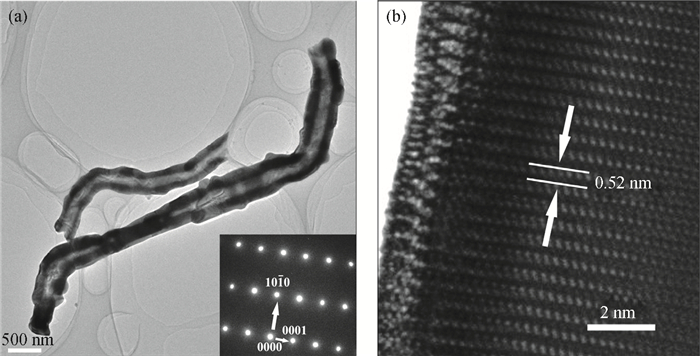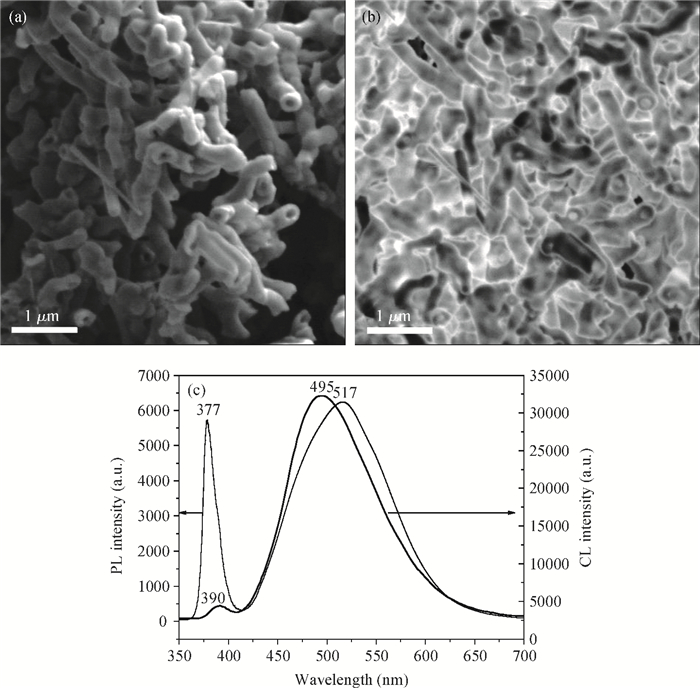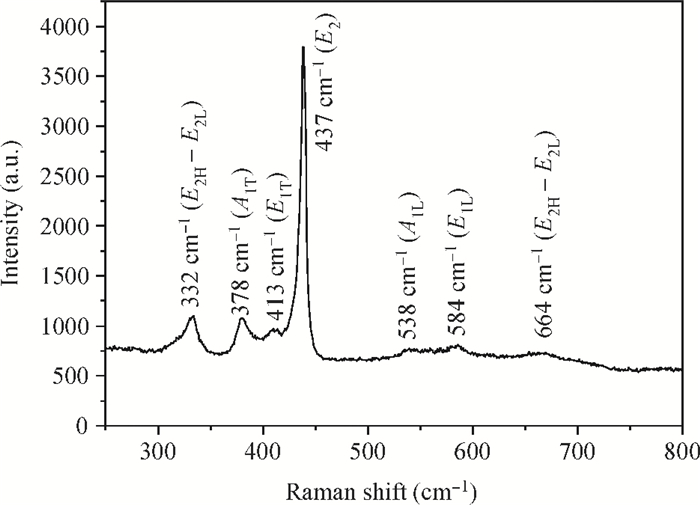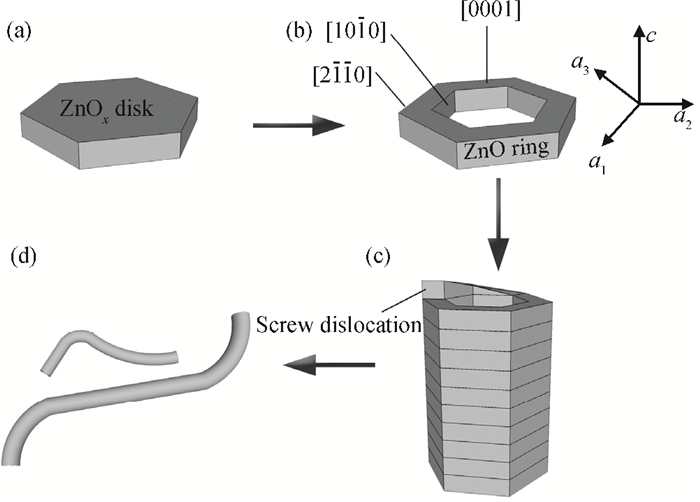| Citation: |
Fuxue Wang, Xiaolong Cai, Dawei Yan, Zhaomin Zhu, Shaoqing Xiao, Xiaofeng Gu. Synthesis and luminescence characteristics of ZnO nanotubes[J]. Journal of Semiconductors, 2014, 35(9): 093004. doi: 10.1088/1674-4926/35/9/093004
****
F X Wang, X L Cai, D W Yan, Z M Zhu, S Q Xiao, X F Gu. Synthesis and luminescence characteristics of ZnO nanotubes[J]. J. Semicond., 2014, 35(9): 093004. doi: 10.1088/1674-4926/35/9/093004.
|
Synthesis and luminescence characteristics of ZnO nanotubes
DOI: 10.1088/1674-4926/35/9/093004
More Information
-
Abstract
ZnO nanotubes have been fabricated through a carbon thermal reduction deposition process. Structure characterization results show that the ZnO nanotubes have a single crystalline wurtzite hexagonal structure preferentially oriented in the c-axis. The diameters of ZnO nanotubes are in the range of 90-280 nm and the wall thickness is about 50-100 nm. Room-temperature photoluminescence measurements of the ZnO nanotubes exhibit an intensive ultraviolet peak at 377 nm and a broad peak centered at about 517 nm. The UV emission is caused by the near band edge emission while the green emission may be attributed to both oxygen vacancy and the surface state. Raman and cathodoluminescence spectra are also discussed. Finally, a possible growth mechanism of the ZnO nanotubes is proposed.-
Keywords:
- ZnO,
- nanotubes,
- photoluminescence,
- cathodoluminescence,
- growth mechanism
-
References
[1] Iijima S. Helical microtubules of graphitic carbon. Nature, 1991, 354(6348):56 doi: 10.1038/354056a0[2] Ceylan H, Ozgit-Akgun C, Erkal T S, et al. Size-controlled conformal nanofabrication of biotemplated three-dimensional TiO2 and ZnO nanonetworks. Scientific Reports, 2013, 3:2306 doi: 10.1038/srep02306[3] Kansal S K, Hassan Ali A, Kapoor S, et al. Preparation, characterization and photocatalytic activity of nanosized ZnO for the degradation of rhodamine B dye and simulated dyebath effluent. Sci Adv Mater, 2013, 5(6):630 doi: 10.1166/sam.2013.1531[4] Yao Z, Apostoluk A, Shibin L, et al. ZnO nanoparticles as a luminescent down-shifting layer for photosensitive devices. Journal of Semiconductors, 2013, 34(5):053005 doi: 10.1088/1674-4926/34/5/053005[5] Yongai Z, Chaoxing W, Yong Z, et al. Synthesis and efficient field emission characteristics of patterned ZnO nanowires. Journal of Semiconductors, 2012, 33(2):023001 doi: 10.1088/1674-4926/33/2/023001[6] Zhitao H, Sisi L, Jinkui C, et al. Controlled growth of well-aligned ZnO nanowire arrays using the improved hydrothermal method. Journal of Semiconductors, 2013, 34(6):063002 doi: 10.1088/1674-4926/34/6/063002[7] Cho S, Kim D H, Lee B S, et al. Ethanol sensors based on ZnO nanotubes with controllable wall thickness via atomic layer deposition, an O2 plasma process and an annealing process. Sensors and Actuators B:Chemical, 2012, 162(1):300[8] Lu H, Zheng F, Guo M, et al. One-step electrodeposition of single-crystal ZnO nanotube arrays and their optical properties. Journal of Alloys and Compounds, 2014, 588:217 doi: 10.1016/j.jallcom.2013.11.055[9] Yu B, Liu C J. Characterization of ZnO nanotube fabricated by the plasma decomposition of Zn (OH)2 via dielectric barrier discharge. Plasma Chemistry and Plasma Processing, 2012, 32(2):201. doi: 10.1007/s11090-011-9337-9[10] Qi K, Yang J, Fu J, et al. Morphology-controllable ZnO rings:ionic liquid-assisted hydrothermal synthesis, growth mechanism and photoluminescence properties. Cryst Eng Comm, 2013, 15(34):6729 doi: 10.1039/c3ce27007f[11] İeksaç T, Kaya F, Kaya C. Hydrothermal synthesis of zinc oxide (ZnO) nanotubes and its electrophoretic deposition on nickel filter. Mater Lett, 2013, 100:11 doi: 10.1016/j.matlet.2013.02.099[12] Yu Q, Yu C, Wang J, et al. Gas sensing properties of self-assembled ZnO nanotube bundles. RSC Adv, 2013, 3(37):16619 doi: 10.1039/c3ra42383b[13] Yang J, Lin Y, Meng Y, et al. Oriented ZnO nanotubes arrays decorated with TiO2 nanoparticles for dye-sensitized solar cell applications. Appl Phys A, 2013, 114(4):1195[14] Zhiming C, Sumei Z, Tongyun C, et al. Acetic acid gas sensors based on Ni2+ doped ZnO nanorods prepared by using the solvothermal method. Journal of Semiconductors, 2012, 33(11):112003 doi: 10.1088/1674-4926/33/11/112003[15] Patra M, Manzoor K, Manoth M, et al. Studies of luminescence properties of ZnO and ZnO:Zn nanorods prepared by solution growth technique. Journal of Luminescence, 2008, 128(2):267 doi: 10.1016/j.jlumin.2007.08.005[16] DjurišiA, Choy W C, Roy V A L, et al. Photoluminescence and electron paramagnetic resonance of ZnO tetrapod structures. Adv Functional Mater, 2004, 14(9):856 doi: 10.1002/(ISSN)1616-3028[17] Wu X, Siu G, Fu C, et al. Photoluminescence and cathodoluminescence studies of stoichiometric and oxygen-deficient ZnO films. Appl Phys Lett, 2001, 78(16):2285 doi: 10.1063/1.1361288[18] Cheng C, Sie E, Liu B, et al. Surface plasmon enhanced band edge luminescence of ZnO nanorods by capping Au nanoparticles. Appl Phys Lett, 2010, 96(7):071107 doi: 10.1063/1.3323091[19] Zhang H, Shen L, Guo S. Insight into the structures and properties of morphology-controlled legs of tetrapod-like ZnO nanostructures. J Phys Chem C, 2007, 111(35):12939 doi: 10.1021/jp074086v[20] Liu Y, Gorla C, Liang S, et al. Ultraviolet detectors based on epitaxial ZnO films grown by MOCVD. J Electron Mater, 2000, 29(1):69 doi: 10.1007/s11664-000-0097-1[21] Chen S, Liu Y, Shao C, et al. Structural and optical properties of uniform ZnO nanosheets. Adv Mater, 2005, 17(5):586 doi: 10.1002/(ISSN)1521-4095[22] Tian X, Pan Z, Zhang H, et al. Preparation and characterization of vertically aligned ZnO microrods on glass substrate. Mater Lett, 2013, 97:71 doi: 10.1016/j.matlet.2013.01.116[23] Zhang T, Zeng Y, Fan H, et al. Synthesis, optical and gas sensitive properties of large-scale aggregative flowerlike ZnO nanostructures via simple route hydrothermal process. J Phys D:Appl Phys, 2009, 42(4):045103[24] Yu Q, Yu C, Yang H, et al. Growth of dumbbell-like ZnO microcrystals under mild conditions and their photoluminescence properties. Inorganic Chemistry, 2007, 46(15):6204 doi: 10.1021/ic070008a[25] Feng L, Liu A, Ma Y, et al. Structural and optical properties of ZnO whiskers grown on ZnO-coated silicon substrates by non-catalytic thermal evaporation process. Physica E:Low-dimensional Systems and Nanostructures, 2010, 42(7):1928[26] Xing Y, Xi Z, Zhang X, et al. Nanotubular structures of zinc oxide. Solid State Commun, 2004, 129(10):671 doi: 10.1016/j.ssc.2003.11.049[27] Morin S A, Bierman M J, Tong J, et al. Mechanism and kinetics of spontaneous nanotube growth driven by screw dislocations. Science, 2010, 328(5977):476 doi: 10.1126/science.1182977[28] Taghavi M, Mattoli V, Mazzolai B, et al. Synthesizing tubular and trapezoidal shaped ZnO nanowires by an aqueous solution method. Nanoscale, 2013, 5(8):3505 doi: 10.1039/c3nr34013a[29] Chi M, Zhao Y, Fan Q, et al. The synthesis of PrB6 nanowires and nanotubes by self-catalyzed method. Ceramics International, 2014, 40(6):8921 doi: 10.1016/j.ceramint.2014.01.046[30] Gao P X, Wang Z L. Mesoporous polyhedral cages and shells formed by textured self-assembly of ZnO nanocrystals. J Ame Chem Soc, 2003, 125(37):11299 doi: 10.1021/ja035569p -
Proportional views





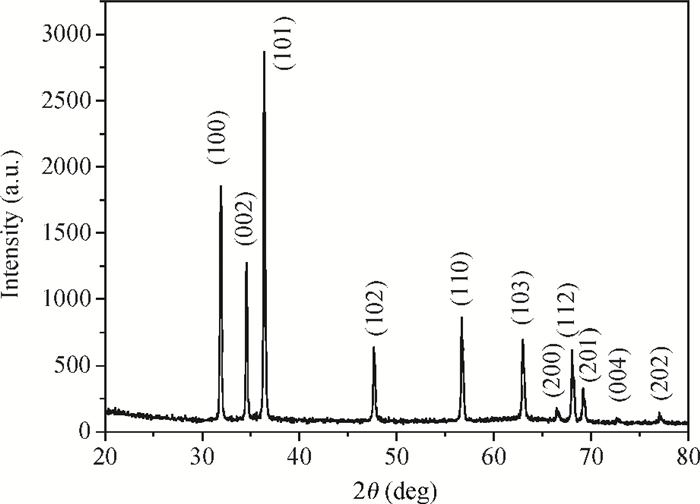
 DownLoad:
DownLoad:
